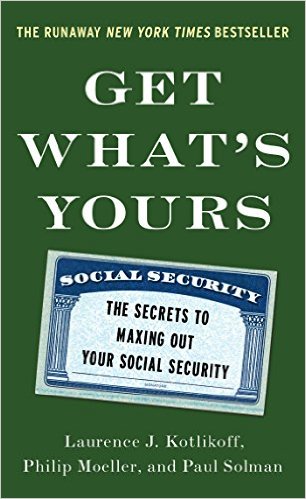I’m not in the habit of telling people, “You absolutely have to read this book!” on account of the fact that people have different tastes and also because most books out there aren’t going to make or break someone. For “Get What’s Yours: The Secrets to Maxing Out Your Social Security” by Laurence Kotlikoff, Philip Moeller, and Paul Solman, I will make an exception. Unless you already have a good grasp of its contents, you absolutely have to read this book.
If you’re young enough, it’s easy to joke that Social Security will be insolvent by the time we’re retired. And it may well be. But: that doesn’t mean you’ll get nothing. You may get less than what you would have received in a perfect world, but you’ll still get something. The question is, how do you (or for many of you, your parents) maximize that something?
And that’s why I especially recommend this book for those of us who are into points and miles. We’re used to approaching rewards and loyalty program algorithmically: here are the rules, here are the sweet spots, here is where you get screwed over, and therefore this is what you ought to do. This book takes the same approach and applies it to social security–which, believe you me, is much more complicated than Chase Ultimate Rewards points.
Probably most of you know that you should wait until age 70 to start collecting your benefits in order to max them out. As it happens, that one fact represented the entirety of my social security strategy, such as it was. But if you learn nothing else from this book (or from this review), I hope you’ll at least pick up the concept of file-and-suspend. Giving the example of a couple named Jan and Paul, the authors write:
Jan should apply for her Social Security retirement benefit when she turned 66, but then “suspend” it. That is, she would make herself eligible for the benefit but wouldn’t take it.
…[When Paul turns] 66, you apply just for a spousal benefit. When you each hit 70, you do as you originally planned–you each take your own retirement benefits, at which point they will start at their highest possible values.
Spousal benefits for four years. That should be almost $50,000…
Do all of you know how spousal benefits work? I had no idea about how they worked before reading this, but now I sort of get it. I say sort of, because this stuff is complex. Consider this admonition later in the book:
Now here comes one of those sentences worthy of boldface: For most people, we advise great caution before filing and suspending benefits. For married people or those with former or deceased spouses, or with qualifying children (or even parents), suspending Social Security benefits eliminates the ability to claim a stand-alone auxiliary benefit. This is because the act of filing for a retirement benefit, even though you suspend it, can trigger a simultaneous claim for an auxiliary benefit. And, as we’ve said throughout the book, you can collect only one benefit at a time.
So yes: it can get complicated. There is much more detail and many more examples than can be conveyed here, but what the book does is equip you to navigate the social security system yourself–which you’ll need to do, because though Social Security staff can tell you how things work, they are technically not allowed to advise you on the best course of action but can only provide information.
But sometimes they have trouble even doing that. Which, though unfortunate, is understandable, since the agency gets more requests for information than any other government agency, including the IRS, while at the same time having fewer resources with which to answer queries.
Nuances notwithstanding, there are some basics that everybody should know. For example, I learned that ten years of marriage is the cutoff point for collecting full spousal benefits. (My wife and I recently passed our ten-year mark, and she was pleased to find this out.) If you were a homemaker with three divorces, each occurring after nine years of marriage, then you are out of luck when it comes to collecting a spousal benefit because you did not hit that ten year mark.
But there’s much, much more; the book is about 300 pages. It can be a little dry at times, but that’s out of necessity due to the subject matter. I can’t imagine making a book about social security any more lively and easier to read than this. Give it a look, check out the reviews, and see if it might be worth your time.

Recent Comments